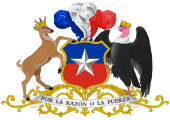 |
|---|
|
|
Since 1925, Chile has conducted eight national referendums. The first modern referendum in 1925 led to the adoption of a new constitution. Over the years, referendums have covered topics such as the legitimacy of General Augusto Pinochet's rule and the adoption of new constitutions in 1980, 2022, and 2023. The current constitution, enacted in 1980, stipulates that binding referendums are required only in specific circumstances, such as when a constitutional reform is fully vetoed by the President and then re-approved by Congress. To date, this presidential power has not been used.
List of referendums
| Year | Referendum | Turnout | Yes | No | Neither | Result | |
|---|---|---|---|---|---|---|---|
| 1812 | Adoption of a provisional political constitution | Approve | |||||
| 1817 | Independence proposal | Approve | |||||
| 1818 | Adoption of a provisional political constitution | Approve | |||||
| 1925 | Adoption of a new political constitution | 45.4% | 94.8% | 4.1% | 1.2% | Approve | |
| Year | Referendum | Turnout | Yes | No | Null | Blank | Result |
| 1978 | Legitimacy of Gen. Augusto Pinochet's dictatorship | a | 78.6% | 21.4% | 4.6% | Approve | |
| 1980 | Adoption of a new political constitution | a | 69.0% | 31.0% | 2.8% | 1.3% | Approve |
| 1988 | Continuance of Pinochet's rule | 97.5% | 44.0% | 56.0% | 1.3% | 1.0% | Reject |
| 1989 | Constitutional reforms | 93.7% | 91.3% | 8.7% | 4.6% | 1.5% | Approve |
| 2020 | On whether a new constitution should be drafted | 51.0% | 78.3% | 21.7% | 0.4% | 0.2% | Approve |
| Year | Referendum | Turnout | MCC | CC | Null | Blank | Result |
| 2020 | On what kind of body should write the new constitution | 51.0% | 21.0% | 79.0% | 3.4% | 1.6% | Constitutional Convention |
| Year | Referendum | Turnout | Yes | No | Null | Blank | Result |
| 2022 | Adoption of a proposed constitution | 85.8% | 38.1% | 61.9% | 1.5% | 0.6% | Reject |
| 2023 | Adoption of a proposed constitution | 84.5% | 44.2% | 55.8% | 3.7% | 1.3% | Reject |
a There was no electoral roll for this referendum.
Note: The percentages used in the "Yes", "No" and "Neither" columns are over the total of valid votes in each referendum. The percentages used in the "Null" and "Blank" columns are over the total votes cast in each referendum.
Current legislation
The 1980 constitution allows for binding referendums only when a constitutional reform passed by Congress is fully vetoed by the President and then re-approved by a two-thirds majority in both chambers. In this case, the President can either sign the reform into law or call for a referendum. So far, no President has used this power.
External links
- Chilean Electoral Service - Official site




